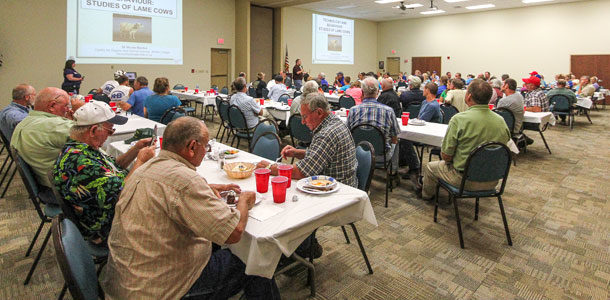Getting younger people and skilled workers into dairy is a struggle not only in the U.S., but even more so in Europe, according to Dr. Nicola Blackie, keynote speaker during the Kentuckiana Dairy Exchange evening program near Campbellsville, Kentucky. She spent a month at the University of Kentucky, seeing how dairy is done in the U.S. and furthering her research on locomotion (mobility) scoring. She said the dairy industry in England is losing cow numbers and people.
Blackie sees the challenges farmers face due to involvement of animal welfare organizations in how new and expanding dairies can do their facility planning and cow management. These factors led Blackie to shift her research focus to locomotion scoring, or “mobility scoring” as it is now called in Europe.
Specifically, she looks for objective measurements that can be quantified and uses computerized technologies such as acclerometers and kinematics to gather data points.
Blackie stressed the importance of making time for mobility scoring, noting that when producers and their employees are trained to do it – and do it often – the results are repeatable and consistent. This consistency is what leads to true early lameness detection. Precision technologies available today assist in this process, she said.
“The best time to do mobility scoring is after milking, if possible,” Blackie suggested. “Choose a flat, nonslip area to observe the cows as they walk at a natural pace, not pushed.”
Blackie found that lying time is affected by social rank, bedding and the stocking rate of the facility. “Most studies suggest lame cows lie down more, but I wanted to know: What does a lame cow actually do, compared with a non-lame cow?” Blackie noted.
Were the lame cows showing signs of avoiding conflict by being up and around in the middle of the night when other cows were lying down? What management practices affected these cows? For example: If the producer feeds once per day, the feed will be sorted by the time a score 2 or 3 cow gets up to eat in the night, or there will be no food left when she gets there. Both scenarios are “not good for the already compromised animal,” she said.
She found the most useful observations are: reduced stride length, negative tracking and reduced stride variation. “The lame cows adopted the most compensating walking pattern and stayed with that pattern to avoid pain,” she observed.
In summary, Blackie found cows with early lameness exhibit a change in lying bouts, a change in behaviors such as when they eat and when they lie down. They do not respond to feed being pushed up – another sign of avoiding conflict with other cows. And they show a change in stride length and reduced variations in how they walk.
During the evening program, Indiana Dairy Producers (IDP) Executive Director Doug Leman also briefed the group on his mid-June trip to Asia as part of a trade mission organized by the Indiana Department of Agriculture to accompany the lieutenant governor.
“There is an obvious and growing demand for protein, but the challenges are some of the tariffs to deal with. They want our products, and we want to level the playing field,” he said. “They told us, ‘We love U.S. products and are willing to pay more for them, but we often feel that your focus is on your invested use and that you won’t produce what we want.’”
A take home message for Leman was that the U.S. dairy industry has opportunities ahead if it is “willing to be flexible.”
On the supply side, Blackie noted the European milk quotas are phasing out. She sees opportunities for young people entering the dairy business in the future without those quotas. But land and labor constraints will keep Europe’s overall production from exploding in the absence of quotas, she reported. PD
Sherry Bunting is a freelance writer based in East Earl, Pennsylvania.
PHOTO
Dr. Nicola Blackie served as the keynote speaker during the Kentuckiana Dairy Exchange evening program, where she shared research about mobility scoring in Europe. Photo by Sherry Bunting.
Read more about the Kentuckiana Dairy Exchange in a related article, "Kentuckiana Dairy Exchange tours central Kentucky dairies," or view the Kentuckiana Dairy Exchange slideshow.




